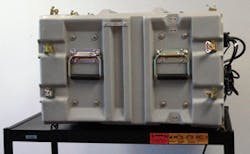American Systems develops emergency communications system for homeland security
By Courtney E. Howard
CHANTILLY, Va. - Engineers at American Systems in Chantilly, Va., are pushing ahead on a project to develop a portion of an integrated homeland security cellular telephone-based emergency alert program called the Crisis Alert initiative.
American Systems won a contract to continue work on the Red Cell program, part of the Institute of Defense and Homeland Security’s Crisis Alert initiative.
Red Cell is to help homeland security authorities make informed decisions and respond to emergencies like chemical, biological, radiological, nuclear, and explosive events. Red Cell also is a public safety service for natural disasters and augments public notification systems like the Wireless Priority Service, Government Emergency Telecommunications Service, and Emergency Alert Service.
Crisis Alert, an integrated emergency alert initiative, focuses on three critical mission areas. First, Red Cell is a cellular telecommunications notification system to ensure that at-risk military and civilian personnel are adequately warned and directed to safety. Second, the Environmental Bioterrorism Detection (EBD) system detects, analyzes, and sends alerts of epidemiological or bioterrorist threats. Finally, the Remote Presence remote sensing systems neutralize the hazard.
For Red Cell, American Systems has devised a geographically precise risk-alert system that combines a sophisticated sensor network with cellular networks. It not only detects man-made and natural threats to public safety, but also alerts the public and engages first-response teams rapidly to save lives.
The Red Cell concept employs a standards-based, network-centric framework to connect sensor networks to public cellular telephone users within a specific cell-tower footprint. Sensors detect an abnormality, or departure from baseline data, and notify appropriate first-response and command-and-control personnel. Those personnel use the sensor data to determine whether it is an actual emergency and whether to notify civilians via the cell-phone network.
The military and homeland security benefits potentially could include: the mitigation of a chemical, biological, radiological, or explosive weapon used against U.S. forces and civilians; earlier detection of threats; more rapid and reliable communications; and the ability to locate at-risk personnel quickly.
“Red Cell fills an information gap in the current emergency communications grid, allowing the public and first responders to take action as effectively and rapidly as possible-in seconds, rather than hours,” says William C. Hoover, chief executive officer of American Systems.
To develop and deploy Red Cell, American Systems has partnered with Wired City in San Leandro, Calif., which provides computer decision support solutions; Amcom Software in Minneapolis, which makes mission-critical communications software; and LineSider Technologies in Danvers, Mass., which helps Internet network operators simplify how they manage IP voice, data, and multimedia operations.
LineSider Technologies WirePower secure network-management technology brings a policy-based approach to network management and adds customization and security to the Internet Protocol infrastructure. WirePower delivers secure connections to critical network nodes based on event notification and command-and-control response protocols.
“Red Cell’s ultimate success is directly related to the security of the system,” Peter Smith, executive vice president of American Systems, explains. “The public trusts that the information they are receiving is accurate and that they can act upon it quickly.”
Amcom Software adds emergency-notification software and assists in the management of the Red Cell emergency notification system.
American Systems and its partners collaborated in a live concept demonstration of Red Cell’s capabilities at the Fort Pickett, Va., National Guard facility last month. Institute of Defense and Homeland Security executives plan a pilot project as a precursor to an operational system.
For more information, visit American Systems online at www.americansystems.com, LineSider Technologies at www.linesider.net, and Amcom Software at www.amcomsoftware.com.

